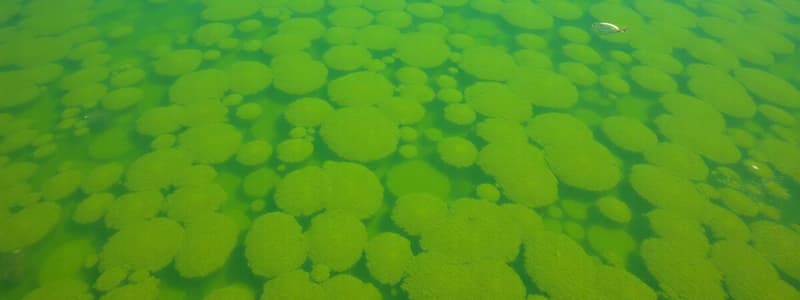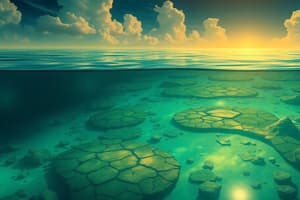Podcast
Questions and Answers
What is the primary consequence of excessive nutrients from sewage in coastal regions?
What is the primary consequence of excessive nutrients from sewage in coastal regions?
- Increased marine biodiversity
- Improved water clarity
- Enhanced fish populations
- Formation of dead zones (correct)
Which of the following best describes the process that occurs during algal blooms?
Which of the following best describes the process that occurs during algal blooms?
- Enhanced sunlight penetration
- Depletion of nutrients
- Increase in fish reproduction
- Competition among algae for oxygen (correct)
What is a significant source of marine pollution related to oil?
What is a significant source of marine pollution related to oil?
- Contaminated rainfall
- Land-based plastic disposal
- Stormwater runoff
- Oil tanker accidents (correct)
How does the disposal of solid waste affect marine life?
How does the disposal of solid waste affect marine life?
What type of waste poses a radiological risk to marine environments?
What type of waste poses a radiological risk to marine environments?
What is a major socio-economic impact of marine pollution?
What is a major socio-economic impact of marine pollution?
Which health risk is commonly associated with consuming contaminated seafood?
Which health risk is commonly associated with consuming contaminated seafood?
What underlying process leads to dead zones in bodies of water?
What underlying process leads to dead zones in bodies of water?
How does marine pollution impact recreational activities?
How does marine pollution impact recreational activities?
What consequence follows the absorption of heavy metals by marine life?
What consequence follows the absorption of heavy metals by marine life?
Flashcards
Eutrophication
Eutrophication
The excessive growth of algae in a body of water due to an increase in nutrients, often caused by human activities like sewage discharge and fertilizer runoff.
Dead Zones
Dead Zones
Areas in the ocean with very low oxygen levels, often caused by eutrophication, which can lead to mass die-offs of marine life.
Oil Spill
Oil Spill
Pollution caused by the release of oil into the environment, often due to accidents like tanker spills or leaks during drilling.
Biomagnification
Biomagnification
Signup and view all the flashcards
Seafood Contamination
Seafood Contamination
Signup and view all the flashcards
Economic Impact of Marine Pollution
Economic Impact of Marine Pollution
Signup and view all the flashcards
Marine Debris
Marine Debris
Signup and view all the flashcards
Radioactive Pollution
Radioactive Pollution
Signup and view all the flashcards
Sewage Discharge
Sewage Discharge
Signup and view all the flashcards
Wastewater Treatment
Wastewater Treatment
Signup and view all the flashcards
Study Notes
Dead Zones in the Gulf of Mexico
-
Area Change: Between 1985 and 2013, the area of dead zones increased by 440%.
-
Gulf of Mexico Issue: Dead zones are becoming a significant problem in the Gulf of Mexico.
-
Evidence for Increasing Problem: Dead zones are increasing in area.
Source of Phosphorus and Nitrogen
- Common Source: Intensive farming is the primary source of phosphorus and nitrogen in the Gulf of Mexico.
Formation of Dead Zones
-
Nutrient Increase: Excessive nutrients from fertilizers run into the water.
-
Eutrophication: This increase in nutrients causes eutrophication, which is an explosive growth of algae.
-
Sunlight Blocking: Algae blooms block sunlight to the lower water levels, preventing photosynthesis.
-
Plant Death: Plants die from insufficient sunlight.
-
Bacterial Decomposition: Bacteria decompose the dead plants, using up oxygen.
-
Lack of Oxygen: Reduction in oxygen levels creates a zone where fish and other marine life cannot survive.
Socio-economic Impacts of Dead Zones
-
Coral Bleaching: Degradation of coral reefs which is evident from the photograph.
-
Fish Kill: Death of fish is observed in the photograph.
-
Tourism Decline: Decline in tourism due to the negative impact on the environment of the region.
-
Economic Loss: Decrease in industry income, from lack of fish and tourism.
Alleviating Dead Zones
-
Sustainable Farming: Implementing sustainable farming practices.
-
Intercropping: Using intercropping methods to reduce fertilizer runoff.
-
Sewage Treatment: Treatment of sewage prior to discharge.
Oil Spills and Seabirds
-
Weight Change: Oil increases the weight of feathers.
-
Insulation: Feathers keep seabirds warm. Oil interferes with the insulation function.
-
Preening: Seabirds preen to clean and maintain their feathers, preventing oil from accumulating.
-
Oil Ingestion: Seabirds may ingest oil, resulting in health issues. This can lead to starvation.
Pollution of Seas
-
Sewage Disposal: Improper sewage disposal (untreated or poorly treated) pollutes the seas.
-
Nutrient Runoff: Excessive nutrients from intensive farming (fertilizers) pollute coastal regions. This causes algal blooms.
-
Solid Waste: Solid waste (e.g., plastics) pollutes the oceans from rivers and sewers.
-
Radioactive Material: Radioactive waste and nuclear tests pollute the ocean, increasing the threat of radioactive contamination.
-
Oil Spills: Oil tanker accidents, oil drilling, and oil runoff contaminate the seas.
Impact on Marine Life
-
Solid Waste: Solid waste can trap or choke marine animals.
-
Chemical Pollution: Contaminated seawater with heavy metals and chemicals affects their health, causing harm or death
-
Food Web: Pollution can contaminate the food web leading to sickness and death of consumers. Pollution travels up the food chain.
Socio-economic Impacts of Sea Pollution
-
Tourism: Decline in tourism due to pollution of coastal areas.
-
Health: Risk of food poisoning due to pollutants in seafood.
-
Expenditure: Increase in government spending on medical treatment.
-
Activities: Suspension of recreational activities due to pollution.
Studying That Suits You
Use AI to generate personalized quizzes and flashcards to suit your learning preferences.




